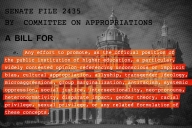You have /5 articles left.
Sign up for a free account or log in.

Sam Edwards/Getty Images
In 2017, the U.S. Department of Education’s Office of Inspector General audited Western Governors University and labeled it a “correspondence education” provider rather than a “distance education” provider.
Only online colleges that provide “regular and substantive interaction” between faculty members and students are considered distance education providers; those that fall short are in the business of correspondence education. The regulation is intended to prevent bad actors from gaining access to federal financial aid funds for courses that are devoid of human interaction. The inspector general found that nearly two-thirds (62 percent) of Western Governors students in the 2014 audit sample took at least one course that failed to meet the distance education requirements. That finding exceeded the government’s 50 percent limit, prompting the government to tell Western Governors to reimburse $713 million in federal financial aid funds.
Later, in 2019, the Education Department’s Office of Federal Student Aid decided that Western Governors need not pay, citing “the ambiguity of the law and regulations and the lack of clear guidance available at the time of the audit period.” That ambiguity has endured to this day, even as the Education Department and colleges nationwide nudge each other toward more clarity about what “regular and substantive interaction” in distance education means.
“We need to be careful about what we ask for because we might just get it,” said Russell Poulin, executive director at WCET and vice president for technology-enhanced education at the Western Interstate Commission for Higher Education, noting that they do want guidance that is as clear as possible. The commission, which advocates for digital learning in postsecondary education, analyzes, interprets and tries to provide examples of what Education Department policies might look like in practice so that its member institutions stay within the sometimes-unwritten guidelines.
To be clear, both the colleges and the Education Department appear to engage in this dialogue in good faith. That is, they share a goal of protecting students as consumers and ensuring that federal financial aid dollars are spent judiciously. But here’s the conundrum: If the Education Department provides too much guidance on what “regular and substantive interaction” means, then colleges may have trouble designing and offering creative, quality programs that meet the needs of their unique student populations. At the same time, if the Education Department provides too little guidance, colleges may run afoul of unarticulated rules.
In 2018, through a negotiated rule-making process, the Trump administration sought to allow more regulatory flexibility in distance learning by defining “regular and substantive interaction” as meeting the standard if it satisfied two of five conditions: “providing direct instruction; assessing or providing feedback on a student’s course work; providing information or responding to questions about the content of a course or competency; facilitating a group discussion regarding the content of a course or competency; or other instructional activities approved by the institution’s or program’s accrediting agency.” But that standard drew criticism, especially given that the last criterion allowed institutions to define “substantive” for themselves.
Last year, Kathryn Kerensky, WCET’s digital learning, policy and compliance director, wrote to the Education Department asking additional, specific questions about the definition of “regular and substantive interaction” in distance education. The communication was one in a series of requests in recent years that have sought to tease out the meaning of “regular and substantive interaction.” Of note is a 2016 WCET blog post, co-authored by Poulin, that offers a noteworthy amount of interpretation on the Education Department’s incomplete guidance on “regular and substantive interaction” in online learning, contributing to its status as the most read post on the site, according to Poulin.
The Education Department replied to Kerensky’s latest queries in a letter dated in March. (The letter was “delayed in transit,” as Kerensky received it in October.) As has been the case in this modern-day saga, the letter delivered both new insight and unanswered questions.
New Guidance on ‘Regular and Substantive’
The Education Department’s 2022 letter to WCET offered some new guidance on what “regular and substantive interaction” in distance education means. Specifically, direct instruction means “live synchronous instruction where both the instructor and the student are online and in communication at the same time.”
“That clarity was very helpful,” Poulin said, noting that member institutions had had different interpretations, including some that considered asynchronous video lectures as direct instruction. Asynchronous videos can still be a value-added component of a course, Poulin noted, but they cannot “count” as part of direct instruction.
Scheduled office hours “can fulfill part of the requirement for regular interaction between instructors and students,” according to the letter. That too was helpful, as some WCET member institutions had reported that some in the financial aid community disagreed with this interpretation.
Also, the Education Department affirmed that it defers to accreditors concerning instructor qualifications necessary for providing “substantive interaction.” To date, colleges have been unclear, for example, whether teaching assistants, graduate students or team instruction might count toward this requirement. In the 2017 case against Western Governors, the government cited concerns about inadequate faculty roles in the institution’s distance education courses. (The competency-based university has an unusual faculty model that has several people performing traditional instructional roles.) Though the Education Department’s letter did not settle this matter, it pointed to where colleges could find the answer, which Poulin noted was a “very helpful” trend in Education Department responses in recent years.
Lingering Questions About ’Regular and Substantive’
Some colleges have been unclear about the degree to which instructors must engage in online group discussions in order for an activity to count as regular and substantive interaction. For example, one institution reported that some online faculty members developed patterns of initiating discussions and returned to the discussion only at the end to grade them, according to the Education Department’s letter. On the question of instructor engagement, the Education Department plans to respond on a case-by-case basis.
“What is the evidence that an institution could provide to demonstrate this?” Poulin asked, noting that college administrators might, for example, coordinate efforts with campus units that can draw data from learning management systems. “It would have been nice to see a couple of examples.”
“With compliance, you want to have those black-and-white standards,” Kerensky said. “It’s challenging for institutions to not have the clear answers. But the drawback of having very prescriptive standards is that there’s not the room to develop outside of that. We appreciate their perspective in leaving some things open.”
Some colleges sought guidance on the kind of evidence that might demonstrate that faculty substantively interact with students, especially as the Education Department had earlier stated that institutions need not “document the exact amount of time spent on any particular type of substantive interaction.” In this most recent letter, the Education Department affirmed earlier guidance that institutions should maintain policies or procedures that “create expectations for faculty to substantively interact with students,” but it declined to comment further about how institutions could implement and enforce these policies.
WCET’s member institutions also sought the department’s guidance on how program design might show that interactions between instructors and students were “prompt and proactive,” as required by the regulations. Earlier, the department had noted that institutions are not required to document “each and every” interaction. But in the most recent communication, the agency declined to offer criteria, such as policies or metrics, for determining whether interactions are prompt and proactive. Instead, the Education Department said that it would be made on a case-by-case basis.
When college administrators and faculty members are unclear about how to comply with the Education Department’s rules, they would be wise to have defensible processes, Kerensky said. That is, a college’s policy for supporting regular and substantive interaction should be clear and should articulate a procedure for ensuring that the policy is enforced. Also, administrators and faculty should be able to argue why the policy and procedures are what they are. That way, should an audited institution be cited for a violation, their defense will be ready.
This bureaucratic dance between the Education Department and online colleges may be imperfect, but neither party appears motivated to change the status quo on how they negotiate distance education requirements.
“We’re trying to push the department to be as clear as it can be but also be careful about what we ask for,” Poulin said, pausing a beat before reiterating, “we don’t want to push them too far.”








